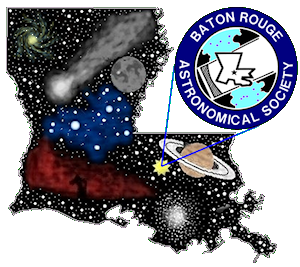
Moonwatcher’s Certificate
NOTE: To print this page from your browser using a color printer, be sure you select "black text" in your "Page setup" (or the equivalents) before printing. Otherwise the white text will not print at all.
Introduction
The Earth♁’s Moon is the most conspicuous natural object that can be seen day and night. It is often taken for granted, yet it yields a plethora of beautiful and fascinating landscape for the curious and the patient. BRAS’ Moonwatcher’s Certificate is tailored for those who are interested in learning the major, basic features of the near side of Moon.
Recommended Ages
Pursuit of the Moonwatcher’s Certificate is recommended for those aged fourteen and older.
Rules and Regulations
To qualify for BRAS’ Moonwatcher’s Certificate, you must be a BRAS member. The observing list consists of—
- --ten unaided-eye features for one point each
- --thirty binocular features for one point each
- --three exercises for two points each
You must obtain forty of the forty-six possible points to earn the Certificate.
If you have trouble with an unaided-eye feature you may use a binocular if absolutely necessary. If you have trouble with a binocular feature you may use a telescope if absolutely necessary. You may not use a telescope for unaided-eye features. The use of a mount with a binocular is allowed.
The Features and Exercises
The checklist is divided into unaided and binocular features. Both section lists features roughly in order of longitude from east to west. A separate checklist grid allows entries for date, time and (for binocular features) magnification. There are also separate worksheets for each of the three exercises.
Unaided [1 PT. EACH]
- Sea of Crises
- Sea of Fertility
- Sea of Serenity
- Sea of Tranquility
- Sea of Nectar
- Sea of Showers
- Sea of Cold
- Sea of Clouds
- Sea of Moisture
- Ocean of Storms
Binocular [1 PT. EACH]
- lunar rays
- Crater Langrenus
- Crater Cleomedes
- Crater Petavius
- Crater Macrobius
- Marsh of Sleep
- Crater Atlas
- Crater Hercules
- Crater Fracastorius
- Crater Posidonius
- Crater Theophilus
- Crater Cyrillus
- Crater Catharina
- Crater Aristoteles
- Crater Eudoxus
- Sea of Vapors
- Central Bay
- Crater Aristillus
- Crater Autolycus
- Crater Archimedes
- Crater Plato
- Crater Tycho
- Crater Clavius
- Bay of Rainbows
- Crater Copernicus
- Crater Bullialdus
- Marsh of Diseases
- Crater Gassendi
- Crater Aristarchus
- Bay of Dew
Exercises [2 PTS. EACH]
*Without consulting an outside source, estimate Full Moon within thirty-six hours.
*Without using a binocular, plot the Moon’s position against the stars for three consecutive nights. Attempt to plot at about the same time every night.
*Sketch a binocular-scale lunar map. Include magnification used, and date and time of sketch.
NOTE: Although knowledge of lunar features’ Latin names is not necessary for this certificate, many maps and other reference resources utilize them. Also, the Astronomical League’ Lunar Club checklist utilizes the Latin names.
The Astronomical League Lunar Club Certificate
Membership in BRAS includes membership in the Astronomical League, a national “umbrella” association of amateur astronomers. The AL’s Lunar Club entails an extended, more intense list of features and exercises. To acquire the Lunar Club Certificate you must be a BRAS member. In addition to the features and exercises listed for the Moonwatcher’s Certificate, the Lunar Club list includes four unaided-eye views of the Moon during certain phases, four unaided-eye “illusions”, sixteen additional binocular features, thirty-six telescopic features and seven additional two-point exercises. You must obtain 100 of the 120 possible points to earn the AL’s Lunar Club Certificate. The forty to forty-six points earned for the Moonwatcher’s Certificate apply toward the Lunar Club Certificate. Details are at <www.astroleague.org>.
Unaided Eye Checklist PDF
Binocular Checklist PDF
Full Moon Estimate Exercise PDF
Moon Plotting Exercise PDF
Moon Sketching Exercise PDF